Auschwitz – my visit in pictures
July 3, 2020
by Martin Odoni
I have never needed the slightest convincing that the Nazi Holocaust really happened. This is certainly no mere matter of ‘faith’, it was one of the most gruesome realities of the Twentieth Century. The demographic evidence alone is overwhelming; by the Nazis’ own calculations, made at the notorious Wansee Conference in 1942 where the fateful command for the ‘Final Solution’ was ratified, the Jewish population of Europe was over eleven million. By 1946, investigations found that there were only between three and four million Jews left in Europe, the vast majority of them in the Soviet Union. That many people do not just ‘disappear’, nor do they flee to other countries without anyone noticing. Horrible though it is, the only explanation that fits the facts is extermination.
So when I visited the notorious extermination-camp-turned-Holocaust-museum at Oświęcim (Germanicism: “Auschwitz“) in Poland, two years ago this week, it was not in order to make a new assessment of the brutally obvious. I was there because, with my Jewish ancestry, I had known for much of my life that it was somewhere I had to visit at some point. My own matrilineal ancestors had been Lithuanian Jews chased out of the Russian Empire during the Pogroms. They ended up in Britain, but all they had to do was take a turn south at the Baltic Sea, and they might instead have settled in Germany or Austria-Hungary – lands the Nazis would dominate in the early-1940s. A chance decision alone had decided not to throttle my entire family in the womb. So I had to observe what might so easily have become of my own grandmother, among others.
There follows a selection of the photographs I took while at the camp, with occasional explanation of context and historical significance, as well as the thoughts and feelings I experienced while I was there. Thanks to my friend, Julia O’Riagan, who was living in Poland at the time and kindly put me up in her spare room, saving me an awkward hotel bill. She also visited the camp with me.


The signs outside the entrance to the Auschwitz I museum.
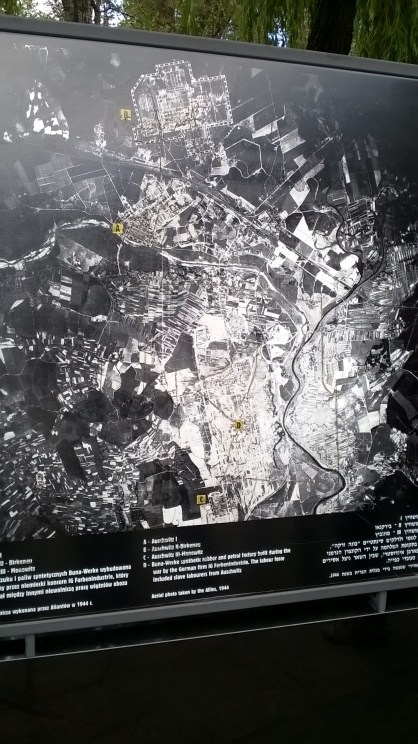
A map giving the layout of the entire complex, including the Auschwitz II: Birkenau second camp, and the unfinished ‘Honowitz’ camp.

Specific map of Auschwitz I.

The notorious entry gate to Auschwitz I with the deeply misleading motto, “Arbeit macht frei”, roughly translating as “Work sets you free” at its crown. How disturbing is it that these sentiments conform so closely to those of Iain Duncan-Smith, and he is close to the top of British Government?

As you can see, it was an unsuitably bright, warm, sunny, cloudless summer’s day to survey the site of one of the most terrible crimes ever committed in human history.
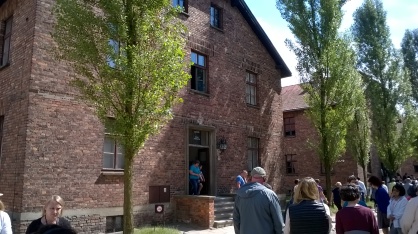
Annexe 4 gives a broad introduction to the workings of the original Auschwitz extermination camp.

The terrifying ‘reach’ of Auschwitz demonstrated by lines that indicate the approximate, unknowing final journeys of over a million Jews – and indeed large numbers of other people – from all over Europe, to their doom in the death-camps of Auschwitz and Birkenau.
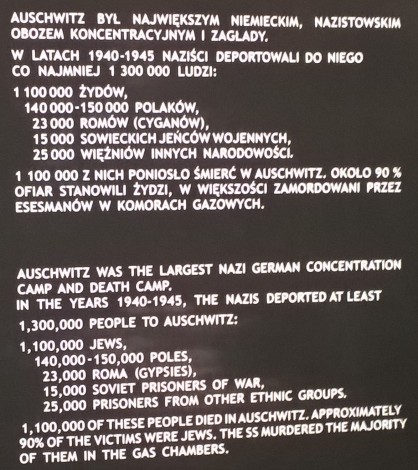
The cold demographic numbers of those who died in Auschwitz and Birkenau.
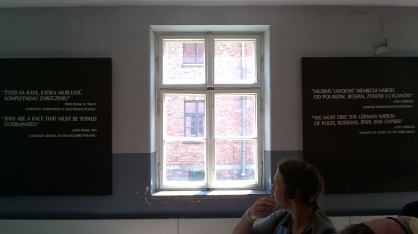
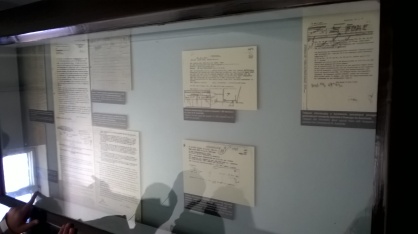






A trainload of doomed prisoners arrive on the platform/ramp at Birkenau, not realising the gruesome fate that awaits them; as a rule, the longer they survive, the more gruesome it becomes.

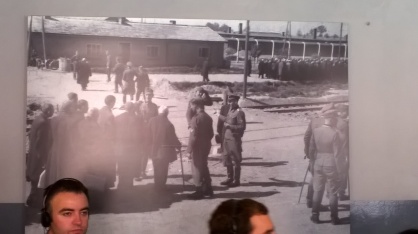

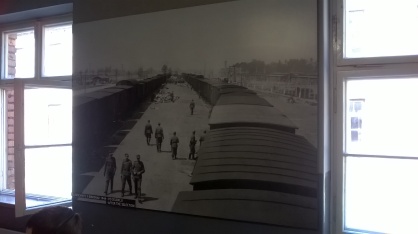
This picture is on a wall in Auschwitz I, but shows the railway platform of Auschwitz II: Birkenau. All the ‘passengers’ on these recently-arrived trains would almost certainly be dead, with their bodies destroyed in ovens, within a year.


An ‘ash-pit’ is filled with created remains on the perimeter of Birkenau.

A scale model in the museum detailing how the camp functioned, first as a concentration camp, second as an extermination camp.


Apologies for the blurred image, but I hope the text is legible enough to make its significance clear.

The grey pellets are samples of the pesticide ‘Zyklon B’, the poison used to exterminate prisoners in the gas chambers of Auschwitz and Birkenau.





Many of the victims of Auschwitz and Birkenau were disabled, and were quietly exterminated to reduce the ‘burden’ they placed on wider Aryan society. Prosthetic limbs were among the many personal items found in the camps after they were liberated near the end of the war.







These are the shoes of many of the prisoners who died in Auschwitz and Birkenau. The sheer volume gives a heartbreakingly clear idea, far more so than the pure numbers, of the scale of the crimes-against-humanity the Nazis committed here.













Surviving prisoner uniforms.

Every single one of these faces is the face of a prisoner who died an obscenely horrible death in either Auschwitz or Birkenau. The great majority of them were Jews, and they were slaughtered, or worked to death, or starved to death, for no other reason than simply because they were Jews. The Shoah was the world’s ultimate manifestation of anti-Semitism.

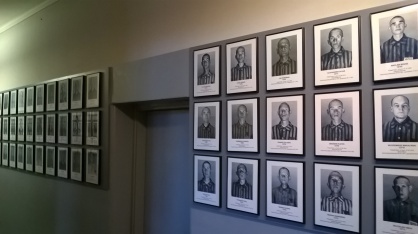



Starvation was as standard a tool of extermination as the rifle in Auschwitz.

This represents a typical day’s ‘food’ for a prisoner in Auschwitz. The average human being needs a diet of around 2,200 calories per day. But a prisoner here was doing remarkably well to get 1,500 calories in a day. And the ‘quality’ of the provisions was pretty well non-existent. The ‘soup’ in the nearest utensil was usually boiled water laced with rotten vegetables – if the prisoners were lucky, that is. It was far from unheard-of for German prison guards to urinate in the pot instead of using water. The loaf of ‘bread’ in the far corner would sometimes be bulked out by adding ‘unconventional’ ingredients, usually sawdust, before baking. The black sludge in the pan on the left was what passed for ‘coffee’, and was the only drink available to prisoners most of the time. Given a human body needs an intake of about eight pints of fluid per day, and this sludge was about as much ‘coffee’ as a prisoner was allowed every twenty-four hours, it was something of a wonder that some prisoners survived long enough to die of hunger instead of thirst.

This famous sculpture is called simply ‘Starvation’. I doubt that, in the context of Auschwitz, any further elaboration is required, or even particularly desirable.


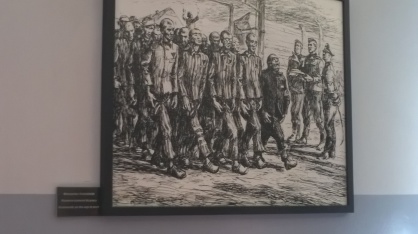

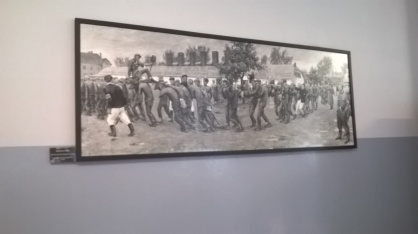




Sometimes, a number like ‘6 million’ is simply too large and too difficult for the human mind to process or envisage. These photographs of many of the victims of Nazi barbarism re-humanise them in a way that numbers simply cannot.



The Nazis were just as ruthless in their treatment of Jewish and Roma children as they were in their treatment of Jewish and Roma adults.

The unspeakable ‘Doctor’ Josef Mengele, possessor of possibly the single most warped mind of all Nazis after Adolf Hitler himself, carried out many of his worst criminal experiments on prisoners during his time as an officer at Auschwitz/Birkenau. Mengele’s gruesome history was brought to terrifying life in the film, Out Of The Ashes, in 2003.

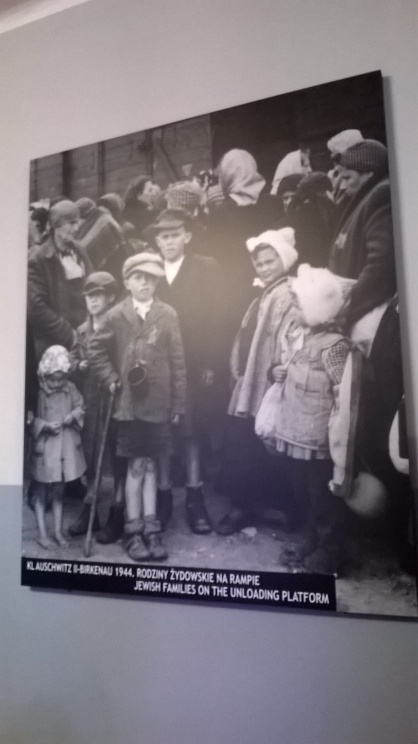
Consider; only about a quarter of prisoners were ever assigned to an annexe within the camps. Most were sent straight to the gas chambers instead. Most of the newly-arrived people in these photographs would therefore have been dead within about two hours of their respective pictures being taken. Yes, including most of the children.



One of the most frightening parts of Auschwitz I was Annexe 8, where female prisoners were used by Nazi medical pseudo-science for human experimentation. Those who died from the treatments were arguably the lucky ones, as the survivors were usually permanently maimed.

The entrance to the execution courtyard – further pictures below – in the shadow of the inner jail.











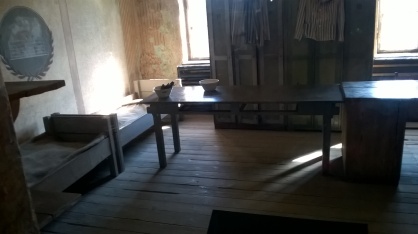

The grey construction at the end of this courtyard is known simply as ‘The Death Wall’, as it was where executions by Nazi firing squads were carried out.

On the same courtyard as ‘The Death Wall’, prisoners sentenced to death by slower, more agonising methods would usually be tied to these posts and left, quite literally, to rot. They served as a terrifying example to other prisoners of the price of disobedience.

This space was used for roll-calls of the prisoners in Auschwitz I. These could start immediately after dawn, and could last as much as half the day, with prisoners forced to stay on their feet in orderly lines for the full duration, usually before they were even allowed to eat.

SS officers would take shelter from the rain inside this booth while watching over prisoner roll-calls, many of which lasted for well over ten hours.






The only crime for which I would support the death penalty is genocide. I therefore approve of what happened to the monstrous Rudolf Höss on this spot in April 1947. Not warmly or with particular enthusiasm, I must stress, but I do approve.

Auschwitz I had a single crematorium/gas chamber for extermination of prisoners and the destruction of their bodies; the notorious ‘Krema I’. Whenever smoke emanated from this chimney, freshly-slaughtered bodies were being burned to ashes within the building. The more active the chimney, the more prisoners had died that day.

A diagram of the partly-reconstructed ‘Krema I’.

The gas-chamber/crematorium (‘Krema I’). This building is a partial reconstruction on the site of the original chamber, which was part-demolished by the Nazis, in a failed attempt to hide evidence of mass-extermination, before abandoning the camp to the Red Army.

Inside Krema I. Apologies for the appalling blurring of the pictures I took in here. I am not ashamed to admit that my hand was shaking while taking them. Julia, who had visited the museum previously, could not bring herself to go back inside the gas chamber/crematorium for another look. I do not blame her in the slightest. Should I ever visit Auschwitz again, I doubt I would want to step back inside that place either.

The entry room to the gas chamber. If anyone ever tells you that the Holocaust ‘never happened’, please read what I have to say below the next picture.

This is the gas chamber in ‘Krema I’. The unknowing victims were marched, naked, into here, under the impression they were just to be showered to remove lice from their bodies before they could start mingling with other prisoners. Once they were all firmly sealed in the chamber, packets of highly toxic ‘Zyklon B’ pesticide were thrown in through hatches in the roof. As you can see, my hands were shaking badly at this point and I was quite unable to take a clear picture. (I could not bring myself even to try and photograph the ovens in the next room.) Interestingly, an American girl in the tour party called Kassady was stood next to me when I took this picture. She had been quite calm and cheerful up until this point, but within seconds of entering this chamber, she suddenly burst into tears. She could actually feel the tragedy almost radiating from the walls around us, as indeed could I. No one who says that the Holocaust never happened should bother trying to convince me to go along with their mindless denials. I have stood in Krema I, and as soon as I was in there, I could feel death all around me. I could feel tragedy had happened on a scale of hundreds of thousands right on the spot where I was stood. It happened. Even without all the evidence proving it happened, you can just stand on that spot and you will know more clearly than ever. It happened.
–

One of the most notorious sights in the world: ‘The Gate Of Death’, entrance to Auschwitz II: Birkenau. Auschwitz I, established in 1940, was struggling with overcrowding after just a year. Thus, less than two miles away, land was seized from the local population and cleared to make way for a secondary camp, one that rapidly grew far larger than the original. Most of the Auschwitz role in the genocide was carried out on the other side of this gate. (Apologies for my finger getting caught in shot bottom-left.)

This single carriage was typical of the transportation used to ship prisoners to concentration/extermination camps. Essentially a cattle-truck, it is only about twenty-five feet long and the width of the railway-line wide, but in the later stages of the war, it would have carried between 100 and 200 prisoners, with no windows, no air, no sanitary facilities, nothing. Hardly surprisingly, huge numbers of prisoners died before the trains even reached Auschwitz. And it could realistically be argued that they were the lucky ones, as the short, agonising life that awaited those who survived the journey was worse than the journey itself.

The platform/ramp that forms the ‘spine’ of Birkenau, where prisoners would be unloaded from trains and face the dreadful ‘selection process’, either to be sent to the gas chambers if they were found to be unfit to work, or to be assigned to the annexes and be slowly worked-and-starved to death. Notice the ‘Gate Of Death’ in the far distance. This is only about a third of the way along the platform, so this gives you an idea of how long the trains, overloaded with prisoners, frequently were, and the mind-curdling numbers of victims involved.
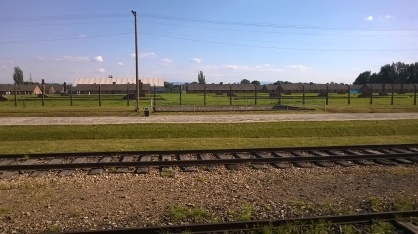
In the fields on either side of the rail-ramp, massively overcrowded annexes housed prisoners in unspeakably bad conditions. Many of the annexes were demolished by the Nazis before abandoning the site to the armies of the Soviet Union, in the vain hope of hiding evidence of the mass-slaughter.


The utterly odious David Irving, the world’s most famous Holocaust-denying, zero-qualifications ‘historian’, claimed that these guard-post contraptions were ‘life-guard’ seats, part of the apparatus for the “swimming pool” he is convinced Birkenau possessed in the role his deranged imagination bestows upon it as a ‘holiday camp’.

As I mentioned earlier, the railway ramp in Birkenau is enormous. You can see the earlier rail carriage in the left half of this picture, with the Gate far beyond it, and this is still a fair walk from the end of the railway line.

At the end of the railway line, stood by an array of memorials to the victims of the Holocaust, looking back towards the ‘Gate Of Death’ – still just barely discernible in the far distance. No, I do not know exactly how far we walked from the Gate to get here, but it took quite some time.

At ‘the end of the line’ – symbolically appropriate – there are memorial stones in many different languages, paying tribute to the victims of Auschwitz and Birkenau. A set of ‘women’s barracks’ were on this spot during the war.


The ‘Prayer of Auschwitz’: “For ever let this place be a cry of despair and a warning to humanity, where the Nazis murdered about one and a half million men, women and children, mainly Jews, from various countries of Europe.”

Just metres from Krema II, for countless Jews, Roma, Russians and Poles, this was, both literally and figuratively, the end-of-the-line.

Most fittingly, one of the memorial stones has ‘The Prayer’ written in Hebrew.

Next to the site of the memorial stones is the wreckage of Krema III, one of four new gas chambers/crematoria to be built in Birkenau. Its demolition near the end of the war was a failed attempt by the Nazis to hide the exterminations. (A key scene of the 2016 movie, Denial, featuring Rachel Weisz and Tom Wilkinson, was filmed in this section of the memorial museum.)

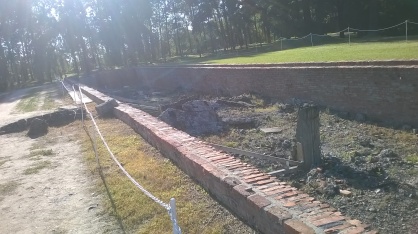


Controversy raged for decades over whether anyone ever found the appropriate holes in this ruined roof of Krema III through which Zyklon B poison was introduced to prisoners inside. In reality, the holes were successfully identified way back in the 1970s, and David Irving’s attempts to revive the controversy in the 1990s and 2000s were really just him ‘flying a kite’, so to speak.

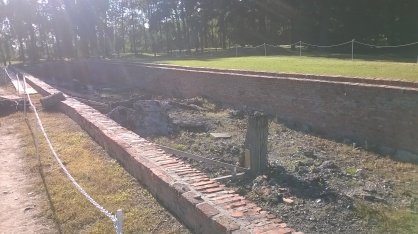


The wreckage of Krema II. Julia caught in the picture.


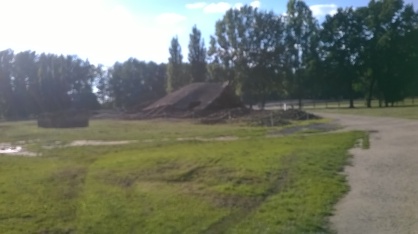

The stone markers in the middle of this picture identify the location of the ash pits, where the burnt remnants of cremated bodies were disposed of like litter.
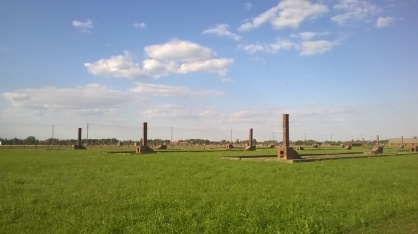

Every one of these annexes could have hundreds of prisoners incarcerated in them at any one time. Most of the annexes had no floorboards, and so prisoners had to walk around, without shoes, on uneven stone ground.




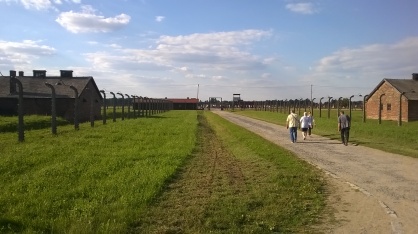

Every annexe on this side of the railway line was used for incarcerating female prisoners.

We were allowed inside one annexe to experience just a hint of the primitive, unhealthy conditions with which prisoners of Birkenau had to contend.

By the final months before the Nazis surrendered Poland, Birkenau was so overcrowded that each of these ‘beds’ (really just shelves) would be occupied by between five and ten prisoners. (The girl in the picture is Kassady, mentioned earlier).

Little luxuries such as floorboards were not to be wasted on prisoners. No, instead, they had to walk barefoot on stones and gravel dust.





Note the graffiti left on the walls.


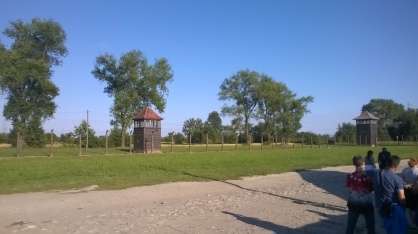
Despite the beautiful summer weather, this day two years ago was one of the most sombre experiences of my life. For all that I knew it was true, never had the Holocaust struck quite as close to me, or seemed as vividly real to me, as it did when I set foot in Auschwitz.
I wish to close with a quick message to any Holocaust-deniers who might be reading this, and who are doubtless rolling their derisive eyes in delusions of ‘superior enlightenment’; –
Please, just give up your silly, childish, racially-driven attempts to ‘excise’ physical facts from the path of history. Stop telling us that the Shoah did not happen. Of course it did. The approximate death-toll of six million, if anything, is somewhat under-stated, not exaggerated. We all know that you do not like Jews, and that you wish the rest of the human race would share in your antipathy, and that can only happen if you can convince them to feel no sympathy for the victims of the Holocaust.
But the obstacle you cannot hurdle is, your wish does not alter facts. Your wish may distort your perception of the facts, but it does not distort the facts themselves. You may wish for the power to force new facts into history, but your wishes, no matter how keenly you feel them, do not give you the power to do that. You may wish to believe that the founders of modern Israel made the whole thing up to justify creating a Jewish Homeland, but they did not. There is no way that all of this was ‘faked‘, and only a willing imbecile would insist it was. The genocide really happened. If I must put it this way then I will; it happened, even though Israel says it happened. We do not even need to bring Israel into this discussion. The Holocaust was real.
And for those who survived the Shoah, it is a matter of completely needless and shearing agony that what they saw, what they heard, what they were made to suffer, is still sometimes dismissed. Dismissed by people who were nowhere near where, were probably not even born at the time, the crimes of the Nazis were committed. Just as white people need to stop telling black people that their experiences of racism are not real, so Holocaust survivors must not be told that the genocide was not real.
And if you still do not believe it, my only advice can be, go and step into Krema I, and listen to the soundless screams that reverberate around its walls.